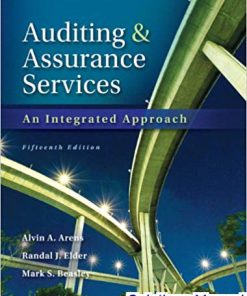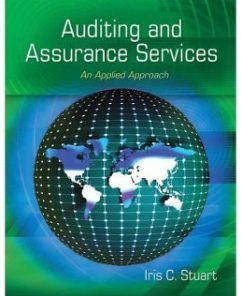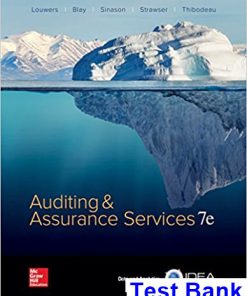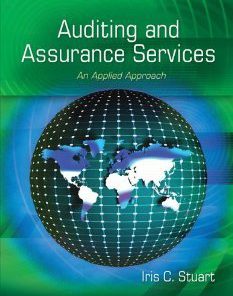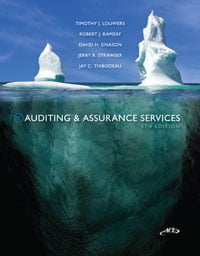Test Bank for Auditing and Assurance Services Understanding the Integrated Audit, 1st edition: Hooks
$35.00 Original price was: $35.00.$26.50Current price is: $26.50.
Test Bank for Auditing and Assurance Services Understanding the Integrated Audit, 1st edition: Hooks
This is completed downloadable of Test Bank for Auditing and Assurance Services Understanding the Integrated Audit, 1st edition: Hooks
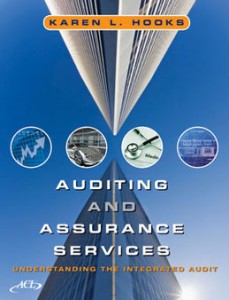
Product Details:
- ISBN-10 : 0471726346
- ISBN-13 : 978-0471726340
- Author: Karen L. Hooks
Auditing and Assurance Services: Understanding the Integrated Audit, by Karen L. Hooks of Florida Atlantic University, presents the auditing profession’s requirement to focus on the integrated audit in the wake of the Sarbanes-Oxley Act (SOX). It also represents the impact of the PCAOB on the auditing of public companies. As the first auditing textbook fully authored after the passage of Sarbanes-Oxley, this book requires students to consider the double-impact of internal controls and financial statements in their considerations.
The author stresses the need for auditors to understand the risks associated with their audit clients and the industries in which they function. Therefore, the cycle chapters each highlight an industry to demonstrate how new public auditors must possess a very strong understanding of risk. Highlighted industries include: health care providers, retail enterprises, the automotive industry, and the land development and home building industry.
Table of Content:
- Part I: Introduction
- Chapter 1: An Introduction to Auditing
- INTRODUCTION
- FINANCIAL STATEMENTS, INTERNAL CONTROL, AND INTEGRATED AUDITS
- DEFINITION OF AN AUDIT
- AUDITING INTERNAL CONTROL OVER FINANCIAL REPORTING
- PURPOSE AND VALUE OF AN AUDIT
- Misstated Financial Statements
- Different Benefits to Different Parties
- Remote Owners and Complex Transactions
- Internal Operations and Management
- SERVICES PROVIDED BY AUDITORS
- STANDARDS SETTERS AND GOVERNING AUTHORITIES
- Federal-Level Authority
- PCAOB Authority
- INTERNAL AUDITORS
- OTHER AUDIT SERVICES
- ACCOUNTANTS WHO ARE NOT AUDITORS
- CONCLUSION
- Key Terms
- Multiple Choice
- Discussion Questions
- Problems
- Activity Assignments
- APPENDIX A: WORKING IN A CPA FIRM
- Services Provided by CPA Firms
- Common Firm Structures
- Firm Size
- Hierarchy within the Firm
- Activity Assignments
- Chapter 2: Overview of an Integrated Audit
- INTRODUCTION
- INTEGRATED AUDITS
- PRELIMINARY REQUIREMENTS FOR AN AUDIT
- OVERVIEW OF AN INTEGRATED AUDIT
- Preliminary Engagement Procedures
- Planning and Risk Assessment
- Tests of ICFR Operating Effectiveness and Substantive Procedures
- Wrap-Up, Completion, and Reporting
- FUNDAMENTAL CONCEPTS
- Management Assertions
- Audit Evidence
- Auditors’ Use of Management Assertions
- More Audit Concepts and Their Relationships
- PRELIMINARY ENGAGEMENT PROCEDURES
- AUDIT PLANNING AND RISK ASSESSMENT
- Preliminary Audit Strategy
- Understanding the Company
- Assessing Risk
- Audit Planning
- TESTS OF ICFR OPERATING EFFECTIVENESS
- SUBSTANTIVE PROCEDURES ON ACCOUNTS AND DISCLOSURES
- WRAP-UP, COMPLETION, AND REPORTING
- NONPUBLIC COMPANY AUDITS
- AUDITING STANDARDS
- General Standards
- Training and Proficiency
- Independence
- Due Professional Care
- Standards of Field Work
- Planning and Supervision
- Understanding
- Evidence
- Reporting Standards
- CONCLUSION
- Key Terms
- Multiple Choice
- Discussion Questions
- Problems
- Activity Assignments
- APPENDIX A: AICPA GENERALLY ACCEPTED AUDITING STANDARDS (AU 150.02)
- General Standards
- Standards of Field Work
- Standards of Reporting
- Part II: The Audit Environment
- Chapter 3: The Auditor’s Role in Society
- INTRODUCTION
- SOCIETY’S RELIANCE ON AUDITORS
- Auditors’ Clients and Other Constituents
- INFLUENCES ON BEHAVIOR
- What Is Right?
- Moral Development
- Ethical Orientation
- AUDITING AS A PROFESSION
- Community of Peers
- Entry and Membership
- External Regulation
- Individual Characteristics
- Social Contracts
- ETHICAL DECISION MAKING
- MORAL DILEMMAS
- EXTERNAL REGULATION
- AICPA CODE OF PROFESSIONAL CONDUCT
- Principles of Professional Conduct
- Rules of Conduct
- PCAOB RULES OF THE BOARD
- AUDITOR INDEPENDENCE
- INDEPENDENCE REQUIREMENTS OF SOX AND THE SEC
- SERVICES THAT IMPAIR FIRM INDEPENDENCE
- PUBLIC ACCOUNTING FIRMS AND QUALITY CONTROL
- PCAOB OVERSIGHT OF FIRMS
- CONCLUSION
- Key Terms
- Multiple Choice
- Discussion Questions
- Problems
- Activity Assignments
- Chapter 4: Legal Environment Affecting Audits
- INTRODUCTION
- AUDITORS AND RISK
- WHO CAN SUE THE AUDITOR?
- Privity
- Near Privity
- Foreseen Third Parties
- Foreseeable Third Parties
- EVENTS INVOLVED IN A LEGAL ACTION
- Arbitration, Negotiations, and Settlements
- Step 1: The Complaint
- Step 2: The Answer
- Step 3: Discovery
- Step 4: Court Proceedings
- Step 5: After the Proceedings
- CAUSES OF ACTION, DEFENSES, AND POTENTIAL DAMAGES
- Negligence and Gross Negligence
- Cause of Action
- Defenses
- Other Defenses
- Damages
- Relevant Cases
- Fraud
- Cause of Action
- Defenses
- Damages
- Relevant Cases
- Breach of Contract
- Cause of Action
- Defenses
- Damages
- Relevant Case
- STATUTORY CIVIL LAW
- Cause of Action, Securities Act of 1933
- Defenses
- Relevant Cases
- Cause of Action, Securities Exchange Act of 1934
- Defenses
- Damages
- Relevant Cases
- GOVERNMENT CIVIL ACTIONS
- SEC Rules of Practice
- Racketeer Influenced and Corrupt Organization Act (RICO)
- Foreign Corrupt Practices Act of 1977
- Sarbanes-Oxley Act of 2002, the Civil Statutes
- CRIMINAL ACTIONS
- Securities Act of 1933 and Securities Exchange Act of 1934, Fraud
- Relevant Cases
- Title 18 § U.S.C. 1512, Obstruction of Justice
- Sarbanes-Oxley Act of 2002
- JURISDICTION
- CONCLUSION
- Key Terms
- Multiple Choice
- Discussion Questions
- Problems
- Activity Assignments
- APPENDIX A: UNITED STATES COURT SYSTEMS
- Stare Decisis
- Subject Matter Jurisdiction
- Private Securities Litigation Reform Act of 1995 and the Securities Litigation Uniform Standards Act
- PART III: Executing an Integrated Audit
- Chapter 5: Client Acceptance and Continuance and Preliminary Engagement Procedures
- INTRODUCTION
- CLIENT ACCEPTANCE AND CONTINUANCE
- GUIDANCE IN THE PROFESSIONAL LITERATURE AND STANDARDS
- OPPORTUNITY FOR A NEW CLIENT
- Independence
- INVESTIGATING THE POTENTIAL CLIENT
- Published Financial Information
- Performance Information
- Accounting Practices and Disclosures
- Management and Board of Directors Integrity
- Company Leadership
- Audit Committee and Board of Directors Involvement and Qualifications
- Potential Client Business Activities
- Financial Statement Restatements
- Public Information Releases by Management
- Organizational Structure
- Financial Difficulty and Going Concern
- Multiple Business Locations
- Client Accounting Function
- Management’s Use of Information
- SOURCES OF INFORMATION
- Publicly Available Information
- Interviewing the Potential Client
- Communication with the Predecessor Auditor
- Business Resources
- Media and Data Searches; Other Investigations
- FIRM RESOURCES AND EXPERTISE
- ECONOMIC CONSIDERATIONS
- PROPOSING ON THE ENGAGEMENT
- AFTER THE SELECTION
- Terms of the Engagement and Engagement Letter
- Confirming Independence
- CONCLUSION
- Key Terms
- Multiple Choice
- Discussion Questions
- Problems
- Activity Assignments
- APPENDIX A: INDUSTRY DESCRIPTIONS
- Manufacturing
- Retailing
- Health Care
- Banking
- Service
- Real Estate Development and Construction
- Hospitality
- Conclusion
- Problem
- APPENDIX B: AUDIT COMMITTEES AND CORPORATE GOVERNANCE
- The Value of Audit Committees
- Composition of Audit Committees
- Audit Committee Charter
- Responsibilities of Audit Committees
- Reports to Audit Committees
- Conclusion
- Problem
- Chapter 6: Audit Planning and Risk Assessment
- INTRODUCTION
- OVERVIEW OF THE PLANNING AND RISK ASSESSMENT PROCESS
- ESTABLISHING THE OVERALL AUDIT STRATEGY
- Scope of the Engagement
- Accounting Presentation
- Entity Structure
- Information Technology
- Client Outsourcing
- Work of Others
- First-Year and Continuing Audits
- Timing
- Materiality and Risk
- Fraud Risk
- Recent Significant Developments
- Sources of Information
- Planning Meeting and Planning Memorandum
- PLANNING THE AUDIT RESOURCES
- Assignments of the Audit Team
- Timing of Audit Work
- Interim and Year End
- Roll Forward
- High-Risk Areas
- Engagement Budget
- AUDIT PLAN
- Nature, Timing, and Extent
- Top Down Approach
- Different Types of Audit Procedures
- COMMUNICATION ON PLANNING
- CONCLUSION
- Key Terms
- Multiple Choice
- Discussion Questions
- Problems
- Activity Assignments
- APPENDIX A: USING THE WORK OF OTHERS
- Internal Auditors and Others
- Responsibility Shared between Independent Auditors
- Deciding to Rely on the Work of Others
- Competence and Objectivity
- Effect on the Independent Auditor’s Work
- Nature of Controls
- Risk
- Judgment Required in the Audit Work
- Estimates and Judgment Affecting the Account
- Evaluating and Testing the Effectiveness of Other’s Work
- Direct Assistance to the Auditor
- Conclusion
- Key Terms
- Multiple Choice
- Discussion Question
- Chapter 7: Understanding Internal Control over Financial Reporting and Auditing Design Effectiveness
- INTRODUCTION
- INTERNAL CONTROL AND RELIABLE FINANCIAL REPORTING
- What is ICFR?
- MANAGEMENT’S MOTIVATION FOR GOOD INTERNAL CONTROL
- THE FINANCIAL STATEMENT AUDIT AND INTERNAL CONTROL OVER FINANCIAL REPORTING
- DEFINITIONS OF INTERNAL CONTROL
- COMPONENTS OF INTERNAL CONTROL
- Control Environment
- Integrity and Ethical Values
- Commitment to Competence
- Board of Directors or Audit Committee Participation
- Management’s Philosophy and Operating Style
- Organizational Structure
- Assignment of Authority and Responsibility
- Human Resources Policies
- Risk Assessment
- Control Activities
- Information and Communication
- Monitoring
- MANAGEMENT’S RESPONSIBILITIES FOR ICFR
- Foreign Corrupt Practices Act
- SOX
- SEC Interpretive Guidance
- BACKGROUND TO AN AUDIT OF ICFR
- MANAGEMENT ASSERTIONS AND AUDIT PROCEDURES
- Management Assertions
- Existence or Occurrence
- Completeness
- Accuracy
- Cutoff
- Classification
- Ownership, Rights, Obligations
- Valuation, Allocation
- ICFR Tests and Time Period Covered
- AUDITOR’S UNDERSTANDING AND ASSESSMENT OF DESIGN EFFECTIVENESS OF ICFR
- Evidence Related to ICFR
- Audit Documentation
- Documentation of the Company’s ICFR
- ENTITY-LEVEL CONTROLS
- Audit Committee and Those in Governance
- Fraud Risk Assessment
- Information Technology
- Period-End Financial Reporting Process
- IDENTIFYING SIGNIFICANT ACCOUNTS, DISCLOSURES, AND RELEVANT ASSERTIONS
- Analyzing the Relevance of Assertions
- Classes of Transactions
- Likely Sources of Misstatements
- IT Related to Likely Sources of Misstatement
- ASSESSING DESIGN EFFECTIVENESS AND CHOOSING THE CONTROLS TO TEST
- CONCLUSION
- Key Terms
- Multiple Choice
- Discussion Questions
- Problems
- Activity Assignments
- APPENDIX A: SPECIFICS OF IT GENERAL CONTROLS
- Introduction
- Approaches to Understanding ITGC
- IT Control Environment
- Policies
- Licensing Agreements
- Passwords
- Use of Company Resources, Internet, and E-mail
- Physical Control over Portable Resources
- Social Engineering
- Control Breakdowns
- Third-party Service Providers
- Segregation of Duties
- Monitoring
- Software Acquisition
- Hardware and Network Technology Acquisition
- Program Development
- Program Changes
- Computer Operations
- Policies and Procedures
- Batch Processing and End User Computing
- Backup Management
- Data Center Controls
- Capacity Planning and Performance Issue Management
- Recovery
- Access to Programs and Data
- Software and Interface Controls
- Contingency Controls
- Backup Procedures
- Service Interruption, Disaster, and Recovery
- Human Resources
- Hiring Policies
- Training
- Termination Policies and Controls
- Physical Facilities and Controls
- ITGC and the Integrated Audit
- Key Terms
- Multiple Choice
- Discussions Questions
- Problem
- Activity Assignment
- APPENDIX B: ENTERPRISE RISK MANAGEMENT, INTEGRATED FRAMEWORK
- Introduction
- Objectives
- Components
- Internal Environment
- Objective Setting
- Event Identification
- Risk Assessment
- Risk Response
- Control Activities
- Information and Communication
- Monitoring
- Roles and Responsibilities
- Limitations of Enterprise Risk Management
- APPENDIX C: INTERNAL CONTROL OVER FINANCIAL REPORTING IN SMALLER PUBLIC COMPANIES
- SEC Interpretive Release
- PCAOB Guidance
- Entity-Level Controls
- Risk of Management Override
- Segregation of Duties
- IT Controls
- Financial Reporting Competencies
- Documentation
- Chapter 8: Planning and Testing Operating Effectiveness of Internal Control over Financial Reporting
- INTRODUCTION
- SELECTING THE CONTROLS TO TEST
- TESTING METHODS
- CAATs
- PLANNING THE TESTS
- Define the Error and Identify Evidence Related to the Error
- Plan the Timing and Extent of Testing
- TIMING OF TESTS
- Benchmarking
- Document Availability
- Updating Interim Audit Work
- EXTENT OF TESTS
- Period-End Reporting Process
- FRAUD
- ILLEGAL ACTS
- RELATED PARTY TRANSACTIONS
- SAMPLING
- Sampling Risk
- Planning the Sample
- Approaches to Sampling
- Nonsampling Risk
- Sampling and ICFR Testing
- AUDIT RISK MODEL
- Other Risks
- Audit Risk Model
- Inherent Risk
- Control Risk
- IT Considerations
- Using the Audit Risk Model for Planning
- AUDIT DOCUMENTATION
- Permanent Files
- Current Files
- Organization, Indexing, and Cross Referencing
- Tick Marks
- EVALUATING THE RESULTS
- Severity of the Deficiency
- AS 5 Definitions of Significant Deficiency, Material Weakness
- Evaluating Deficiencies
- ADDITIONAL DOCUMENTATION CONSIDERATIONS
- “BIG PICTURE” TOPICS AND OPERATING EFFECTIVENESS
- Entity-Level Controls
- Soft Controls and Personnel Qualifications
- Preventive and Detective Controls
- Materiality
- IMPACT OF MULTIPLE LOCATIONS AND BUSINESS UNITS
- IMPACT OF OUTSOURCING
- ICFR EFFECTIVENESS AND THE FINANCIAL STATEMENT AUDIT
- CONCLUSION
- Key Terms
- Multiple Choice
- Discussion Questions
- Problems
- Activity Assignments
- APPENDIX A: TESTING IT APPLICATION CONTROLS AND COMPUTER-ASSISTED AUDIT SOFTWARE
- Testing IT Controls
- Test Data Approach
- Parallel Simulation
- Integrated Test Facility
- Using Computer-Assisted Audit Software to Facilitate Testing
- Key Terms
- Multiple Choice
- Activity Assignments
- APPENDIX B: STATISTICAL TECHNIQUES AND TESTS OF CONTROLS
- Chapter 9: Substantive Procedures and the Financial Statement Audit
- INTRODUCTION
- TRANSACTION CYCLES AND ACCOUNT BALANCES
- Organizing the Audit Tasks
- Management Assertions, Audit Objectives, and Evidence
- MATERIALITY AND REASONABLE ASSURANCE
- Impacts of Sampling
- Sampling Error
- Analytical Procedures
- Audit Risk Model
- PERFORMING SUBSTANTIVE TESTS AND PROCEDURES
- Conclusions as a Result of Substantive Tests and Procedures: Evaluating Results
- Substantive Analytical Procedures
- Tolerable Misstatement and Unadjusted Differences
- Misstatements from Fraud or Error
- AUDIT DOCUMENTATION
- Working Trial Balance, Lead Schedules, and Detailed Work Papers
- IMPORTANT CONSIDERATIONS IN A FINANCIAL STATEMENT AUDIT
- Estimates
- Fair Value Measurements and Disclosures
- Illegal Acts
- Related Party Transactions
- Going Concern
- Cutoff Issues and Substantive Procedures at Interim Dates
- AREAS ADDRESSED IN A FINANCIAL STATEMENT AUDIT
- Cash
- Receivables
- Inventory
- Investments, Emphasis on Marketable Securities
- Prepaid Assets
- Long-Term Productive Assets
- Current Payables
- Long-Term Debt
- Owners’ Equity
- Revenue and Expenses
- SUMMARY OF SUBSTANTIVE TESTS AND PROCEDURES
- CONCLUSION
- Key Terms
- Multiple Choice
- Discussion Questions
- Problems
- Activity Assignments
- APPENDIX A: STATISTICAL TECHNIQUES AND TESTS OF DETAILS OF BALANCES
- Classical Variables Sampling
- Sampling Without Replacement
- An Example Using Classical Variables Sampling
- Monetary Unit Sampling
- MUS with Anticipated Misstatements
- An Example Using Monetary Unit Sampling
- Key Terms
- Multiple Choice
- Chapter 10: Auditing Revenue Processes: Sales, Billing, and Collection in the Health-Care Provider a
- INTRODUCTION
- OVERVIEW
- HEALTH-CARE PROVIDERS
- RETAILING
- BUSINESS PROCESSES, DOCUMENTS, AND INTERNAL CONTROLS
- Revenue Recognition
- Sales
- Managing Bad Debts
- Documents and Processes
- Potential Misstatements and Controls
- MANAGEMENT ASSERTIONS IN AN INTEGRATED AUDIT
- Design Effectiveness
- Operating Effectiveness
- Financial Statement Assertions
- AUDIT TESTS AND PROCEDURES
- TESTS OF CONTROLS
- Tests of Controls for Sales
- Tests of Controls for Sales Returns and Allowances
- Tests of Controls for Cash Receipts
- SUBSTANTIVE PROCEDURES: DUAL PURPOSE TESTS, ANALYTICAL PROCEDURES, AND TESTS OF DETAILS OF BALANCES
- Dual Purpose Tests
- Substantive Analytical Procedures
- TESTS OF DETAILS OF BALANCES
- External Confirmations
- Accounts Receivable Confirmations
- Confirmations of Other Financial Statement Accounts
- Bank Confirmations
- Aging of Accounts Receivable
- Cash
- AUDITING SALES, BILLING, AND COLLECTIONS IN THE HEALTH-CARE PROVIDER INDUSTRY
- AUDITING SALES, BILLING, AND COLLECTIONS IN THE RETAIL INDUSTRY
- CONCLUSION
- Key Terms
- Multiple Choice
- Discussion Questions
- Problems
- Activity Assignments
- Chapter 11: Completing the Integrated Audit and Reporting
- INTRODUCTION
- FINAL AUDIT PROCEDURES
- Unusual Year-End Transactions
- Contingent Liabilities and Commitments
- Inquiry of a Client’s Lawyer
- Management’s Written Representations
- Subsequent Events Review
- New Information after the Date of the Audit Report
- Going Concern
- Other Published Information
- Other Financial Statements and Financial Statement Disclosures
- Communications
- Final Review
- Review of Audit Documentation
- Engagement Quality Review
- REPORTING
- Dating the Report
- Dating the Report with New Information after the Audit Report Date
- New Information after the Financial Statements Are Released
- Integrated Audit Opinion Dates
- Reissuing an Audit Report
- REPORTING ON THE AUDIT OF THE FINANCIAL STATEMENTS
- Introductory Paragraph
- Scope Paragraph
- Opinion Paragraph
- FINANCIAL STATEMENT AUDIT REPORTS THAT DIFFER FROM UNQUALIFIED, STANDARD REPORTS
- Explanatory Language
- Opinion Based in Part on the Report of Another Auditor
- Substantial Doubt about an Entity’s Ability to Continue as a Going Concern
- Changes Affecting Consistency within or between Periods
- Consistency: Change in Accounting Principle
- Consistency: Changes in the Method of Applying an Accounting Principle
- Consistency: Accounting Changes Expected to Have a Material Future Effect
- Consistency: Correction of a Material Misstatement in Previously Issued Financial Statements
- Emphasis of a Matter
- Departure from a Promulgated Accounting Principle
- Qualified, Adverse, and Disclaimer Financial Statement Audit Reports
- Qualified Opinion for a Departure from Generally Accepted Accounting Principles
- Qualified Financial Statement Audit Opinion Because of a Scope Limitation
- Adverse Opinion
- Disclaimer of Opinion
- REPORTING ON AN AUDIT OF INTERNAL CONTROL OVER FINANCIAL REPORTING
- Audit Reports on ICFR that are not Unqualified
- CONCLUSION
- Key Terms
- Multiple Choice
- Discussion Questions
- Problems
- Activity Assignments
- PART IV: ADDITIONAL TRANSACTION CYCLES AND OTHER TOPICS
- Chapter 12: Auditing Acquisition and Payments Processes: Purchases, Cash Disbursements, and Related
- INTRODUCTION
- OVERVIEW
- ACQUISITION AND PAYMENT ASPECTS OF RETAILING
- ACQUISITION AND PAYMENT ASPECTS OF MANUFACTURING
- ACQUISITION AND PAYMENT CONSIDERATIONS OF OTHER ENVIRONMENTS
- THE AUTOMOTIVE INDUSTRY: AN OVERVIEW
- Business Risks Associated with Purchasing Activities
- Reliance on Vendors
- Managing Acquisition-Related Costs
- Types of Acquisitions and Payments
- BUSINESS PROCESSES, DOCUMENTS, AND INTERNAL CONTROL
- Documents and Processes
- Potential Misstatements and Controls
- Segregation of Duties
- Safeguarding Assets
- Accounting Processes
- Cutoff
- Cash Disbursement Procedures
- AUDIT TESTS AND PROCEDURES
- TESTS OF CONTROLS FOR PURCHASES AND EXPENDITURE TRANSACTIONS
- TESTS OF CONTROLS FOR PURCHASE RETURNS AND DISCOUNTS
- TESTS OF CONTROLS FOR CASH DISBURSEMENTS
- DUAL PURPOSE TESTS
- SUBSTANTIVE ANALYTICAL PROCEDURES
- TESTS OF DETAILS OF BALANCES
- Accounts Payable Confirmations
- Search for Unrecorded Liabilities
- Tests of Details of Balances for Accounts Payable
- AUDIT OF PREPAID EXPENSES AND ACCRUED LIABILITIES
- AUDIT OF EXPENSES
- Account Analysis
- Allocation Analysis
- AUDIT OF PROPERTY, PLANT AND EQUIPMENT
- Additions and Disposals
- Impaired Value
- Depreciation
- AUDIT OF INTANGIBLE ASSETS
- AUDITING ACQUISITIONS AND PAYMENTS IN THE AUTOMOTIVE INDUSTRY
- ICFR
- Inventory Costing and Period Expenses
- Estimated Accounts
- Long-Term Assets
- Accounts Payable and Accrued Liabilities
- Disclosures
- CONCLUSION
- Key Terms
- Multiple Choice
- Discussion Questions
- Problems
- Activity Assignments
- Chapter 13: Auditing Human Resources Processes: Personnel and Payroll in the Services Industries
- INTRODUCTION
- OVERVIEW
- HUMAN RESOURCES ASPECTS OF PUBLIC ACCOUNTING
- BUSINESS PROCESSES, DOCUMENTS, AND INTERNAL CONTROLS
- Balance Sheet and Income Statement Effects
- Government Required Records and Reports
- Integration with Cost Accounting Records
- Documents and Processes
- Use of an Imprest Payroll Account
- Potential Misstatements and Controls
- USING AN OUTSIDE SERVICE PROVIDER FOR PAYROLL: OVERVIEW
- User Company Functions
- Inputs to the Outside Service Provider
- Processing by the Service Provider
- Outputs of the Service Provider
- User Company Controls
- REPORTS ON THE PROCESSING OF TRANSACTIONS BY A SERVICE ORGANIZATION
- AUDIT TESTS AND PROCEDURES
- TESTS OF CONTROLS FOR HUMAN RESOURCES TRANSACTIONS
- TESTS OF CONTROLS FOR PAYROLL CASH DISBURSEMENTS
- DUAL PURPOSE TESTS
- SUBSTANTIVE ANALYTICAL PROCEDURES
- TESTS OF DETAILS OF BALANCES
- HUMAN RESOURCES RELATED DISCLOSURES
- AUDIT OF SHARE-BASED COMPENSATION
- AUDITING HUMAN RESOURCES IN THE SERVICES INDUSTRIES
- CONCLUSION
- Key Terms
- Multiple Choice
- Discussion Questions
- Problems
- Activity Assignments
- APPENDIX A: AN ENGAGEMENT TO ISSUE A REPORT ON THE PROCESSING OF TRANSACTIONS BY A SERVICE ORGANIZAT
- Types of Engagements
- Responsibilities of the Service Auditor
- Performing the Engagement
- Service Organization’s Report
- Service Auditor Activities for a Report on Controls in Place
- Service Auditor Activities for a Report on Controls Placed in Operation and Tests of Operating Effec
- Service Auditor Reports
- Type I Report
- Type II Report
- Conclusion
- Chapter 14: Auditing Inventory Processes: Tracking and Costing Products in the Land Development and
- INTRODUCTION
- OVERVIEW
- LAND DEVELOPMENT AND HOME BUILDING INDUSTRY
- Costing Inventory
- Allocation of Common Costs
- Inventory Valuation
- Variable Interest Entities
- Revenue Recognition
- INVENTORY IN THE MANUFACTURING ENVIRONMENT: OVERVIEW
- BUSINESS PROCESSES, DOCUMENTS, AND INTERNAL CONTROLS
- ACCOUNTING FOR INVENTORY
- Valuing Inventory
- Documents and Processes
- Potential Misstatements and Controls
- AUDIT TESTS AND PROCEDURES
- Tests of Controls
- Dual Purpose Tests
- Substantive Analytical Procedures
- TESTS OF DETAILS OF BALANCES
- Inventory Observation
- Auditing Estimates
- Tests of Account Balances
- Auditing Inventory Disclosures
- AUDITING INVENTORY IN THE LAND DEVELOPMENT AND HOME BUILDING INDUSTRY
- Specific Identification of Costs of Inventory
- Estimates and Allocations
- Valuation
- Risks of Construction Defects and Long-Term Product Problems
- CONCLUSION
- Key Terms
- Multiple Choice
- Discussion Questions
- Problems
- Activity Assignments
- Chapter 15: Auditing Assets, Liabilities, and Equity Related to the Financing Cycle
- INTRODUCTION
- OVERVIEW
- ASSETS AND THE FINANCING CYCLE
- Cash and Near Cash
- What is a Cash Equivalent?
- Auditing Cash and Near Cash
- Disclosure
- Investments
- Investment Transactions
- Accounting for Investments
- Valuing Investments
- Tests of Controls and Dual Purpose Tests
- Substantive Analytical Procedures
- Tests of Details of Balances
- Auditing Other Comprehensive Income
- Auditing the Consolidation Process
- Auditing Disclosures
- LIABILITIES AND THE FINANCING CYCLE
- Long-Term Debt
- Other Long-Term Accounts
- Tests of Controls and Dual Purpose Tests
- Substantive Analytical Procedures
- Tests of Details of Balances
- Debt Covenants
- Auditing Pensions and Postretirement Benefits Accounts
- Using the Work of a Specialist
- Auditing Taxes
- Auditing Disclosures
- EQUITY AND THE FINANCING CYCLE
- Equity Transactions and Activities
- Tests of Controls and Dual Purpose Tests
- Substantive Analytical Procedures
- Tests of Details of Balances
- Auditing Mergers and Acquisitions
- Auditing Retained Earnings
- Auditing Disclosures
- AUDITING RELATED PARTY TRANSACTIONS
- CONCLUSION
- Key Terms
- Multiple Choice
- Discussion Questions
- Problems
- Activity Assignments
- Chapter 16: Topics Beyond the Integrated Audit
- INTRODUCTION
- FORENSIC ACCOUNTING
- Differences between Audit and Forensic Accounting
- Fraud Triangle
- Evidence
- Career Paths
- INTERNAL AUDITING
- Code of Ethics
- Professional Standards
- SOX Compliance
- Internal Audit Careers
- STATE AND LOCAL GOVERNMENT AUDITS
- Single Audit Act
- GOVERNMENT AUDITING STANDARDS AND THE YELLOW BOOK
- GOVERNMENT ACCOUNTABILITY OFFICE (GAO) ACTIVITIES
- GAO Careers
- COMPILATION AND REVIEW ENGAGEMENTS
- Compilations
- Reviews
- ATTEST ENGAGEMENTS
- SEC-RELATED ENGAGEMENTS
- Letters for Underwriters
- Interim Financial Information
- Activities Related to Registration Statements
- CONCLUSION
- Key Terms
- Multiple Choice
- Discussion Questions
- Problems
- Activity Assignments
- APPENDIX A: INSTITUTE OF INTERNAL AUDITORS, CODE OF ETHICS
- APPENDIX B: INSTITUTE OF INTERNAL AUDITORS, INTERNATIONAL STANDARDS FOR THE PROFESSIONAL PRACTICE OF
- APPENDIX C: YELLOW BOOK ETHICAL PRINCIPLES
- APPENDIX D: ILLUSTRATIVE INQUIRIES FOR A SSARS REVIEW ENGAGEMENT
- Index
- Text Credits
- Endpapers
People Also Search:
auditing and assurance services understanding the integrated audit 1st edition
auditing and assurance services understanding the integrated audit
auditing and assurance services understanding the integrated audit 1st edition download scribd
auditing and assurance services understanding the integrated audit 1st edition testbank download pdf
You may also like…
Solution Manual
Auditing And Assurance Services An Integrated Approach 15th Edition Arens Solutions Manual
Solution Manual
Solution manual for Auditing and Assurance Services: An Applied Approach Stuart 1st Edition




